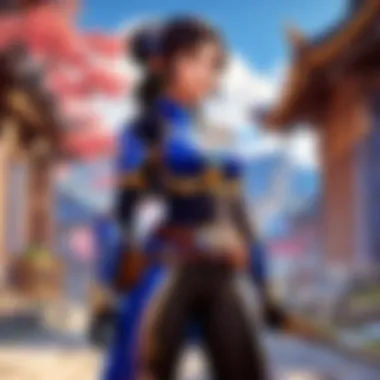Understanding Genshin Impact's Age Rating: Insights & Implications


Intro
The age rating of a game like Genshin Impact is much more than just a number. It plays a crucial role in shaping the player experience and community dynamics. This article will explore the various facets of age ratings and their implications, focusing on Genshin Impact. It will cover the reasoning behind the game's classification, how it influences different demographics, and what it means for parents considering the game for younger players.
Game Updates and Patch Notes
Age ratings can often coincide with changes made in the game through updates and patches. While Genshin Impact is developed by miHoYo, this section serves to highlight how ongoing developments may necessitate reassessment of age-related concerns.
Overview of Recent Game Updates
Genshin Impact frequently receives updates that can introduce new content, characters, and even mechanics. Though these changes primarily aim to enhance player engagement, they also can alter the context of game interactions. Thus, the implications may impact the perception of its age appropriateness.
Detailed Breakdown of Patch Notes and Changes
Each update comes with patch notes detailing what has been adjusted. For example:
- New characters with unique abilities.
- Adjustments in game balance affecting combat styles.
- Introduction of new quests that may involve mature themes.
Analysis of Impact on Gameplay and Community Feedback
The reception of updates can vary. Some players embrace new elements, while others voice concerns, especially regarding the appropriateness of specific content for younger audiences. Understanding this feedback is essential for discerning how age ratings can influence community feelings and player enjoyment.
Understanding Age Ratings
Age ratings are intended to inform players and guardians about suitable content. The rating assigned to Genshin Impact can greatly impact its accessibility to different age groups.
Rating System and Categories
Rating systems, like the ESRB in North America and PEGI in Europe, categorize games based on content. Genshin Impact is rated as T for Teen, primarily due to its fantasy violence and mild suggestive themes. Understanding these categories is vital for parents and players alike.
Implications for Player Demographics
Different age groups may interact with Genshin Impact in distinct ways. Younger players might focus on exploration and character collection, while older players may appreciate the narrative complexity and community engagement that comes from competitive play. Age ratings inform both groups about what to expect and prepare for.
Parental Concerns
Parents are often wary of any game that their children engage with. Various concerns revolve around violent content, social interactions, and in-game purchasing strategies.
Addressing Common Concerns
It is essential for parents to be aware of the potential drawbacks of Genshin Impact. Common worries include:
- Exposure to online interactions with strangers.
- The allure of gacha mechanics which can lead to spending.
- The thematic elements that may not resonate well with younger players.
Suggestions for Parents
Parents are encouraged to play alongside their children to understand the game better. Regular discussions about in-game experiences can provide insights into their child’s interactions, making it a more unified gaming experience.
Closure
In summary, the age rating of Genshin Impact is not a mere formality; it is a multifaceted aspect of the game's identity that impacts player experience on various levels. By comprehending how these ratings shape gameplay and community interaction, we gain a deeper understanding of modern gaming environments, ensuring they are enjoyable and appropriate for all players.
Prologue to Genshin Impact
In the realm of video games, few titles have managed to capture the attention of players worldwide quite like Genshin Impact. Released by miHoYo in September 2020, this action role-playing game has garnered a massive player base and widespread acclaim. Examining Genshin Impact is essential for understanding not only its rich gameplay mechanics but also the broader implications of its age rating, which can significantly influence the gaming experiences of its diverse audience.
The age rating serves as a critical guide for players and their guardians, reflecting the content within the game and its suitability for various age groups. As a multi-faceted product, Genshin Impact blends exploration, adventure, and narrative depth, making it a prime candidate for examination through the lens of age-appropriate content.


Understanding this game involves recognizing the unique aspects that contribute to its appeal. Its expansive world, combined with intricate storytelling and character design, engages players of different demographics. Moreover, the game is free-to-play, making it accessible yet potentially prone to age-related concerns given its monetization strategy. As such, understanding age ratings is not just about categorizing games; it involves recognizing the responsibilities of developers, the concerns of parents, and the interactions between various player demographics, which will be elaborated upon in subsequent sections.
Overview of the Game
Genshin Impact features an open world environment called Teyvat, rich in lore and opportunities for exploration. Players navigate through seven nations, each of which is associated with different elements and deities. The game employs an action-based combat system, allowing players to switch between a cast of diverse characters, each possessing unique abilities. This diversity in gameplay encourages both strategic team compositions and varied combat experiences.
The game also incorporates a gacha system, where players can acquire new characters and equipment through random draws, an aspect that has triggered both fascination and concern among different player groups due to its associated costs.
Genshin Impact's visual presentation is striking, characterized by anime-style graphics that appeal to a range of players. The soundtrack further enhances immersion, creating an inviting atmosphere for exploration and adventure.
Popularity and Cultural Impact
Since its launch, Genshin Impact has experienced exponential growth in popularity. The combination of engaging gameplay, stunning visuals, and intricate storylines has sparked conversation across various platforms, from social media to gaming forums. Its multi-platform accessibility allows players to enjoy the game on mobile devices, PCs, and consoles, extending its reach.
Culturally, Genshin Impact has set a precedent for how free-to-play games can compete with fully priced titles. Players often share clips, tips, and fan art on platforms like Reddit and Facebook, creating a vibrant community. The presence of events like cosplay and fan conventions represents how the game has transcended digital boundaries, entering the realm of social interaction.
Understanding Age Ratings
The concept of age ratings carries significant weight in the gaming industry, serving as a guideline for players, parents, and developers alike. They provide essential insights into what content is deemed suitable for various age groups. Understanding these ratings helps players make informed decisions, ensuring that their gaming experience aligns with personal values and social norms. Moreover, for parents, these ratings act as a protective measure, allowing them to manage their children's exposure to potentially sensitive themes. Lastly, developers must navigate these ratings meticulously, as they can influence marketing strategies and community reception.
What Are Age Ratings?
Age ratings are classifications that indicate the appropriateness of video game content for different age groups. These ratings assess factors such as violence, language, and themes that may be unsuitable for younger audiences. The goal is to guide consumers, promoting safe gaming experiences.
These ratings are crucial not just for compliance, but also for fostering an informed gaming community. They facilitate discussions about content and its impact on players. Without these guidelines, players and parents would have limited resources to evaluate the suitability of a game.
Different Rating Systems
ESRB
The Entertainment Software Rating Board (ESRB) is a prominent rating system in North America. It offers clear, concise labels that categorize games into various age groups, such as 'E' for Everyone or 'M' for Mature. ESRB is particularly beneficial for its simplicity and widespread recognition, ensuring that players quickly understand the content suitability.
One unique feature of the ESRB system is its comprehensive use of content descriptors, such as
Genshin Impact's Age Rating
The age rating of Genshin Impact carries significant weight. It establishes a framework for understanding who can engage with the game. Age ratings not only reflect content considerations but also address broader societal expectations about media consumption. For parents and players, this rating translates into a guideline for determining appropriateness. In the case of Genshin Impact, it highlights the game's themes and gameplay elements that might influence the player experience.
Official Rating Breakdown
Genshin Impact has received specific age ratings from various organizations. For instance, the Entertainment Software Rating Board (ESRB) has categorized it as T for Teen, while the Pan European Game Information (PEGI) rates it 12. These ratings suggest that the game is suitable for players age 12 and above, though it may contain some content that could be considered inappropriate for younger audiences.
The age rating is not just a number; it encapsulates the expectations of the gaming community regarding content standards.
These ratings are important because they help guide discussions among gamers, parents, and educators. They also serve as a crucial reference point for the game's content, which may include battle scenes and moments of conflict.
Content Considered for Rating
The age rating for Genshin Impact takes various content elements into account. Each of these facets plays a significant role in shaping the final rating.
Violence
In Genshin Impact, violence manifests primarily through combat mechanics. Players frequently engage in battles against a range of adversaries. The violence isn't graphic but displays character abilities and interactions through magical effects. This level of violence is typical for action RPGs, offering a style of conflict that is often less intense compared to other genres. Gamers may appreciate the balance between engaging gameplay and moderate violence, which avoids excessive gore. Thus, it positions Genshin Impact as an appealing choice for a teenage audience.
Language
Language in Genshin Impact may also contribute to its age rating. While the dialogue is generally appropriate, there are instances of mild language that parents might find unsuitable. The game does not contain profanity, yet it engages with themes of friendship, conflict, and betrayal that might introduce a complex narrative. This layer adds depth and resonates with older players, making it an important aspect of the overall experience. The language used fosters more profound engagement but may not align with younger players' maturity levels.


Suggestive Themes
Suggestive themes appear subtly throughout the game. Genshin Impact incorporates character design and storylines that might be viewed as partially mature. These elements elevate the narrative but also pose potential concerns for younger audiences. While these themes are not explicit, they do touch upon relationships and emotional situations that may be better understood by older players. This characteristic adds to the game's multifaceted design, appealing primarily to its intended demographic while still allowing some parental discretion.
In analyzing these content aspects, it becomes clear that the age rating for Genshin Impact provides essential insights into gameplay, community dynamics, and parental perceptions. Understanding these factors is crucial for informed discussions and decision-making regarding the game.
Implications of the Age Rating
Understanding the implications of age ratings is crucial for several reasons. Age ratings serve to inform players and parents about the content of a game like Genshin Impact. This knowledge shapes who engages with the game and how these individuals perceive the gaming experience. It affects not just the gameplay but also influences social interactions within the community. The implications extend beyond individual players, reaching into discussions about community standards and industry practices. Here, we dive deep into these implications to highlight their significance.
Impact on Player Demographics
The age rating of Genshin Impact plays a pivotal role in determining its player base. The game is rated T for Teen by the ESRB, which suggests it is suitable for players aged 13 and older. This rating directly influences who feels comfortable playing the game. Younger players, or their parents, may decide against it due to the perception of mature themes. In contrast, older teens may find the content more appealing, as it aligns with their interests and understanding.
Additionally, the way that different age demographics interact with the game can vary widely. Younger players may focus more on exploration and character building, while older players often engage with the game's lore and complexity. Knowing these age-related preferences can help in tailoring game updates or events to better fit the audience’s desires. Thus, the age rating helps Genshin Impact maintain a broad appeal while respecting the suitability for its players.
Community Reactions and Discussions
The response from the gaming community towards the age rating of Genshin Impact tends to be mixed. Some players appreciate that the game is accessible to younger audiences, fostering a more diverse player base. Others may argue that certain elements within the game, such as character design or storyline, can be viewed as inappropriate for all age groups. This division sparks lively discussions on platforms such as Reddit and gaming forums.
- Positive reactions often emphasize:
- Conversely, concerns include:
- The inclusivity of younger players in community spaces.
- Opportunities for parents and children to share experiences in gaming.
- Discussions on the nature of violence, even if mild compared to other titles.
- The presence of suggestive themes, considering how they are interpreted by various age groups.
These factors contribute to broader discussions on age appropriateness in gaming. The community often debates whether the current age rating accurately reflects the content, leading to calls for reevaluation or clearer communication from the developers. Ultimately, these dialogues contribute to writing new norms in gaming culture, influencing not just player interaction but also developer accountability.
Ultimately, the implications of age ratings go beyond numbers; they shape the very fabric of gaming communities and affect players at multiple levels.
Parental Concerns
Parental concerns are essential when discussing video games such as Genshin Impact. Understanding age ratings helps parents make informed decisions about what games are appropriate for their children. Age ratings provide a guideline based on content factors like violence, language, and themes that may not be suitable for younger audiences. This understanding is crucial for fostering a safe gaming environment and ensuring that children engage with age-appropriate material.
The Genshin Impact platform offers a vast world filled with exploration, adventure, and social interaction. While these elements can be exciting, they also present challenges regarding gamer age appropriateness. Parents often wonder whether such games are entirely free from harmful concepts. Recognizing these concerns will allow for a more nuanced engagement between parents and their children about gaming choices.
Understanding Parental Guidance
Parental guidance extends beyond merely checking the age rating number printed on a game case. It involves actively engaging with the content and understanding its implications. Tools such as game reviews, forums, and community feedback provide parents with additional context.
Parents should consider the following factors:
- Content themes: Analyze the game’s message and context. Genshin Impact, for example, features fantastical elements, but emotional maturity levels can vary.
- Gameplay engagement: Observe how your child interacts with the game. Does it encourage positive social interactions or lead to isolation?
- Time spent: Managing screen time is essential for maintaining balance in children's lives.
These elements help parents establish a foundation for what games their children can enjoy without exposing them to potentially adverse effects.
Facilitating Healthy Discussions
Facilitating healthy discussions as a family about games is crucial. Communicating openly can aid in demystifying gaming for children. When parents take the time to talk about the content of Genshin Impact, they can discuss the implications of in-game actions and choices made by characters.
Here are some ways to promote these discussions:
- Ask open-ended questions: Encourage players to express their thoughts about game choices or character motivations.
- Share personal experiences: Relate personal gaming experiences and how they shaped understanding of certain themes.
- Set expectations: Clearly communicate what is appropriate versus inappropriate regarding gaming experiences.
By promoting thoughtful conversations around video gaming, parents can help children navigate complex themes while developing their critical thinking skills.
Understanding age ratings and facilitating conversations about gaming enable better decision-making and enrich the experience for children.


Industry Responsibility
The age rating of a game like Genshin Impact has significant implications not only for its players but also for those who develop and market the game. This section delves into the responsibilities of the industry in ensuring that age ratings are clear, accurate, and reflect the game's content properly. The gaming industry’s initiatives are tied closely to how games are perceived by different audiences, particularly parents and young players. Therefore, understanding industry responsibility is crucial in maintaining trust and fostering healthy gaming environments.
The Role of Developers
Developers play a pivotal role in shaping the content of games and how they fit within age rating systems. In the case of Genshin Impact, developers at miHoYo must consider various factors during the design and production phases. This includes not only gameplay mechanics and visual design but also the narrative elements that can affect age ratings. For instance, when incorporating fantasy violence or suggestive themes, developers need to gauge how these will resonate with different age groups.
Transparency in content creation can enhance the credibility of the game and its rating. Developers should clearly communicate the themes and content found within the game, allowing players and parents to make informed decisions. Furthermore, collaborations with rating organizations can provide useful feedback on potential issues before the game is released, helping to prevent misclassification.
Influence on Marketing Strategies
Marketing strategies for games like Genshin Impact are undeniably intertwined with their age ratings. When developers know the rating of their game, they can tailor their marketing efforts accordingly. For example, a game rated for older teenagers might focus its advertising on platforms frequented by that demographic, while a game deemed suitable for younger players can employ more child-friendly campaigns.
Moreover, the age rating influences the messaging used in advertisements. Campaigns may highlight gameplay features that align with the expectations of the target age group, ensuring that the marketing resonates well without misleading potential players about the overall experience of the game. The responsible representation of game content in marketing, supported by suitable age ratings, establishes a framework where parents feel more secure in allowing their children to play.
"Effective age ratings and responsible marketing strategies are essential for fostering a safe and informed gaming environment for all players."
Ultimately, the responsibility of the industry does not end with the developers. It extends to all stakeholders involved in the creation, distribution, and marketing of the game, ensuring that appropriateness is prioritized right from development to consumer interaction.
Comparative Analysis
Comparative analysis plays a crucial role in understanding the age rating of Genshin Impact and its implications. This section allows for a broader context, placing Genshin Impact among its peers within the gaming industry. By exploring similar games, we can identify patterns in age ratings and content classifications. This approach helps to assess whether the ratings given to Genshin Impact align with those of comparable titles or if they diverge significantly due to particular themes or elements.
Furthermore, understanding how Genshin Impact is rated in comparison to similar games sheds light on market expectations and player demographics. This analysis can inform parents and players alike about the appropriateness of the game, providing a benchmark for assessing the suitability of Genshin Impact based on the experiences of other games.
Similar Games and Their Ratings
When evaluating Genshin Impact, examining ratings of similar titles is essential. Games like The Legend of Zelda: Breath of the Wild, Final Fantasy XV, and Honkai Impact 3rd provide a useful backdrop. Each of these games has its unique style, narrative, and target audience, yet they share substantial gameplay mechanics and visual aesthetics with Genshin Impact.
- The Legend of Zelda: Breath of the Wild is rated E10+ by the ESRB. The fantasy violence present is encouraged by its engaging narrative and world-building.
- Final Fantasy XV carries a T rating, due to its fantasy violence, some blood, and strong language. The age rating reflects its dense narrative and character development, which may appeal to older teens.
- Honkai Impact 3rd also has a T rating, similar to Genshin Impact, reflecting comparable themes and target audiences.
These comparisons highlight how Genshin Impact's T rating aligns with industry norms for titles featuring adventure and RPG elements. Furthermore, such scrutiny points to how player demographics tend to gravitate towards games within these ratings, influencing their engagement and gameplay experiences.
Effectiveness of Ratings in Comparison
The effectiveness of age ratings serves as a tool for guiding consumers. While ratings provide a structured framework, the interpretation of their implications can vary. Many players and parents weigh these ratings alongside gameplay experiences.
When considering the effectiveness of age ratings, several factors come into play:
- Clarity and Transparency: The ESRB and PEGI systems are generally clear. However, the nuances of content can sometimes cause confusion.
- Consistency: Games alike with similar themes often garner similar ratings, but exceptions exist. This may lead to questions about the consistency of ratings across games.
- Cultural Differences: Age ratings can differ based on cultural contexts. A game viewed as suitable for teenagers in one region might be restricted for the same age group elsewhere.
Understanding how effective these ratings are can inform future industry practices. As developers consider their audiences, they may learn to adjust the content of their games to align with the ratings that resonate best with those audiences.
In summary, the comparative analysis of Genshin Impact against similar games illuminates not just industry standards but also shapes perceptions regarding age appropriateness, granting insights to both players and parents navigating the gaming landscape.
The effectiveness of age ratings relies not only on the consistency of application but also on the evolving perceptions of player demographics.
Endings
Understanding the age rating of Genshin Impact is crucial for various stakeholders, including players, parents, and industry professionals. This section summarizes the key findings of the article and discusses thoughts for the future regarding age ratings and their implications.
Summary of Findings
Through this article, we have explored several important aspects of Genshin Impact's age rating. The official ratings provided by organizations like the ESRB, PEGI, and USK shed light on content considerations such as violence, language, and suggestive themes.
The implications of these ratings affect player demographics significantly. Different age groups engage with the game in unique ways, shaped by their understanding and reception of the content. Community reactions reveal a spectrum of perspectives, where some players embrace the game while others express concern.
Parental guidance plays an essential role, as many parents seek to understand how age ratings impact their children’s gaming experience. The game’s developers carry responsibility to adhere to guidelines while also considering player feedback for future updates. Marketing strategies are also influenced, as games must be presented appropriately to the right audience. Overall, age ratings are not just classifications but are instrumental in shaping perceptions, gameplay experiences, and community dynamics within the gaming landscape.
Future Considerations
Looking ahead, it is imperative that all players understand the significance of age ratings in gaming. As the industry evolves, age ratings may need to adapt to new trends and shifts in gaming culture. The conversation surrounding these ratings is ongoing, and future research could explore their effectiveness in different cultural contexts.
Evaluating the effectiveness of current rating systems could result in more refined classifications, ensuring that they meet the needs of diverse audiences. Additionally, engaging players in discussions about content awareness can empower them to make informed choices.



